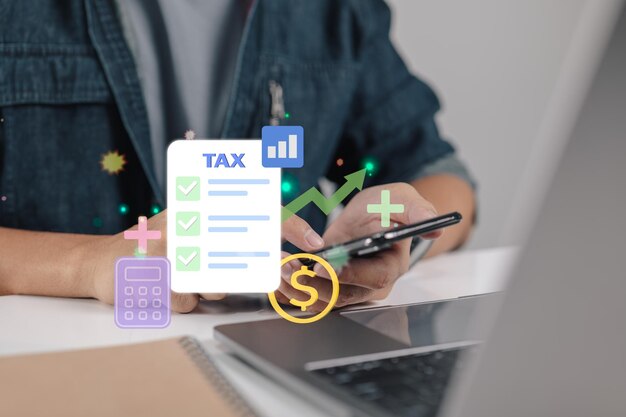
In today’s rapidly changing economic landscape, businesses across various sectors are facing unprecedented challenges. To mitigate these difficulties and support business continuity, governments worldwide have introduced a range of tax relief measures.
These initiatives are designed to provide much-needed financial respite and help businesses navigate through turbulent times. Among these measures, the Employee Retention Credit (ERC) stands out as a significant boon, offering substantial aid to employers committed to retaining their workforce. This blog post aims to demystify the latest tax relief measures, with a special focus on how to effectively claim the ERC.
Understanding these measures is crucial for business owners seeking to stabilize their operations and safeguard their future. Let’s delve into the intricacies of these tax reliefs, unraveling how they can be a lifeline for businesses in this era of economic uncertainty.
Overview of Tax Relief Measures
In response to the economic strain faced by businesses, several tax relief measures have been introduced to provide support and alleviate financial burdens. These measures range from deferrals of tax payments to credits that directly reduce tax liability. A notable example is the Employee Retention Credit (ERC), a substantial tax relief initiative designed to encourage businesses to keep employees on their payroll.
Other measures include temporary reductions in certain tax rates, accelerated depreciation allowances, and amendments to loss-carryback rules, enabling businesses to offset current losses against past profits. Some jurisdictions have also introduced specific reliefs targeting industries most affected by the economic downturn, such as hospitality and retail.
Moreover, many governments are offering enhanced deductions or credits for businesses investing in areas like health and safety improvements or digital infrastructure, recognizing the need for adaptation in these challenging times. These measures not only provide immediate financial relief but also encourage long-term investments that can drive future growth.
Understanding these varied tax relief measures is critical for business owners. It allows them to identify which incentives are most relevant to their situation and how to strategically leverage them for maximum benefit. The following sections will delve deeper into these measures, particularly focusing on how to effectively claim the ERC, a key component in this suite of tax incentives.
Eligibility Criteria for Tax Relief
Eligibility for the various tax relief measures varies, depending on the specific provisions set by the governing bodies. It’s essential for business owners to understand these criteria to determine their qualification for these incentives, including the much-discussed Employee Retention Credit (ERC).
For the ERC, eligible businesses are those that have experienced significant disruptions in their operations due to government-imposed restrictions or notable declines in gross receipts compared to previous periods. This includes businesses of all sizes, but the specifics can vary, such as the percentage drop in revenue required to qualify.
In addition to the ERC, other tax relief measures may have different eligibility criteria. For instance, some tax credits might be available only to small or medium-sized enterprises or to businesses operating in certain sectors like manufacturing or technology. Deductions for investments in health and safety improvements might require compliance with specific standards or certifications.
It’s imperative for businesses to thoroughly review these criteria or consult with a tax professional to ensure they meet the eligibility requirements. Missing out on these details can lead to overlooking valuable relief opportunities. Up next, we will explore in detail how businesses can claim the ERC, a critical component of the current tax relief offerings, and how it can significantly benefit them during these challenging times.
How to Claim the ERC (Employee Retention Credit)

Claiming the Employee Retention Credit (ERC) can provide substantial financial relief for businesses striving to retain employees during challenging economic times.
Here’s a step-by-step guide to navigating this process:
- Determine Eligibility: First, assess if your business qualifies for the ERC. Eligibility criteria include experiencing a significant decline in gross receipts or being subject to full or partial suspension of operations due to government orders related to COVID-19. Specific thresholds and requirements vary, so it’s important to review the latest guidelines.
- Calculate Qualifying Wages: Once eligibility is confirmed, identify the wages that qualify for the credit. This includes salaries, wages, and certain health insurance costs paid to employees during eligible quarters. The calculation differs depending on your business size and the specific time frame.
- Complete the Necessary Forms: Claim the ERC by filling out the appropriate forms with the IRS. For most businesses, this will involve adjusting quarterly employment tax returns using Form 941-X. Ensure all information is accurate to avoid processing delays or audits.
- Documentation and Record-Keeping: Maintain thorough documentation of your eligibility and calculations. This should include records of gross receipts, employee wage details, and any relevant government orders affecting your business operations.
- Seek Professional Advice: Given the complexities of tax laws, consider consulting with a tax professional or accountant. They can provide valuable assistance in determining eligibility, calculating the credit, and ensuring compliance with all requirements.
By following these steps, businesses can successfully claim the ERC, gaining crucial financial support to help retain their workforce and navigate the economic impacts of the pandemic. It’s a valuable opportunity that should not be overlooked by eligible businesses.
Maximizing Benefits from Tax Relief Measures
To fully leverage the benefits of available tax relief measures, businesses need a strategic approach. Maximizing these benefits not only aids in immediate financial relief but also sets a foundation for long-term fiscal health.
Firstly, it’s crucial to have a comprehensive understanding of all the tax relief options available, including the Employee Retention Credit (ERC). Businesses should assess each option to see how it aligns with their specific circumstances. This might involve analyzing financial records to identify eligibility for different credits or deductions.
Keeping accurate and detailed financial records is another key step. Proper documentation of revenue declines, employee wages, and qualifying expenses is essential, especially when claiming credits like the ERC. These records should be easily accessible and well-organized to streamline the claim process.
Additionally, consider the timing of claims. In some cases, timing can impact the extent of benefits received. Understanding the deadlines and procedural requirements for each tax relief measure ensures that opportunities are not missed.
Businesses may also benefit from consulting with tax professionals. These experts can provide tailored advice, identify often-overlooked relief opportunities, and assist in navigating the complexities of tax laws and regulations.
Finally, integrating tax relief measures into broader financial planning can enhance overall business strategy. This integration can help in balancing immediate financial needs with long-term growth and stability goals, turning these challenging times into an opportunity for resilience and growth.
Common Challenges and Solutions
While navigating tax relief measures like the Employee Retention Credit (ERC) offers significant advantages, businesses often encounter several challenges. Understanding these obstacles and their solutions is crucial for the effective and efficient utilization of these incentives.
- Complex Eligibility Criteria: One of the main challenges is deciphering complex eligibility criteria for various tax reliefs, including the ERC. The solution lies in thorough research and, if needed, consultation with tax professionals. They can help clarify ambiguities and ensure your business meets all necessary requirements.
- Maintaining Accurate Records: Accurate and detailed record-keeping is essential but can be overwhelming. Implementing a robust accounting system and regularly updating financial records are key to managing this challenge. Such practices make it easier to provide necessary documentation when claiming tax relief.
- Navigating Changing Regulations: Tax laws and relief measures can frequently change, especially in turbulent economic times. Staying informed about these changes is vital. Subscribing to tax law updates, attending relevant webinars, or working with a tax advisor can help you stay on top of these changes.
- Balancing Immediate Relief and Long-Term Planning: Often, businesses focus on immediate relief, potentially overlooking long-term implications. The solution is to integrate tax relief measures into the broader financial strategy of the company, ensuring both immediate benefit and alignment with long-term financial goals.
- Application Process Complexity: The process of applying for tax reliefs like the ERC can be daunting. Leverage available resources, such as online guides or government helplines, and don’t hesitate to seek professional assistance to navigate the application process smoothly.
By addressing these common challenges with informed and strategic solutions, businesses can effectively claim and benefit from tax relief measures, turning potential obstacles into opportunities for financial stability and growth.
Looking Ahead: Future of Business Taxation
As we look towards the future, the landscape of business taxation is poised to evolve continually. The recent introduction of measures like the Employee Retention Credit (ERC) signals a shift towards more dynamic and responsive tax policies, especially in times of economic uncertainty. Businesses should anticipate and prepare for ongoing changes that may arise as governments adjust their fiscal strategies to balance economic support with broader financial responsibilities.
Staying informed about potential tax reforms and emerging incentives will be crucial for businesses to adapt and plan effectively. This could involve regularly consulting with tax professionals, attending industry seminars, and keeping an eye on legislative developments. Additionally, integrating flexibility into financial planning will allow businesses to swiftly respond to new tax measures and incentives as they arise.
The future of business taxation may bring challenges, but it also offers opportunities for those who remain proactive, informed, and adaptable. By embracing these principles, businesses can navigate the complexities of taxation while positioning themselves for sustained growth and stability.
Conclusion
In conclusion, navigating the latest tax relief measures, including claiming the ERC, is essential for businesses seeking financial stability in challenging times. Understanding the intricacies of these measures, maintaining accurate records, staying informed about changes, and seeking professional advice are key to maximizing their benefits. As the landscape of business taxation continues to evolve, adaptability and informed decision-making will be crucial. By embracing these strategies, businesses can not only weather current economic challenges but also position themselves for future growth and success.
Read Also:




























